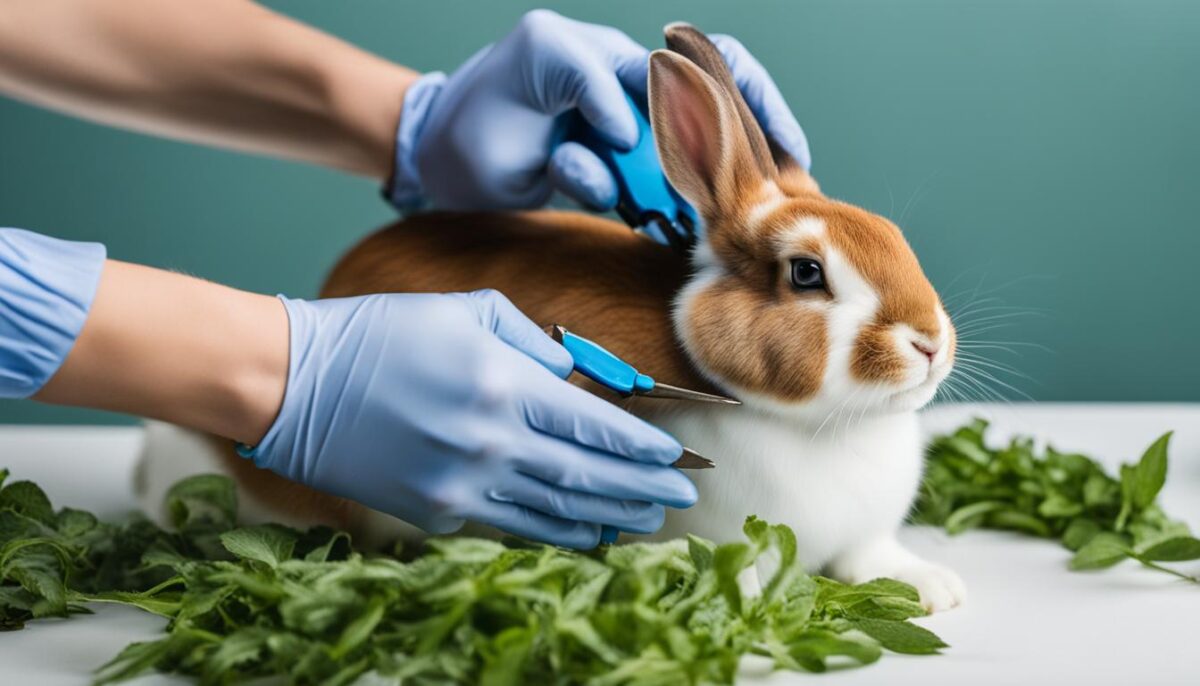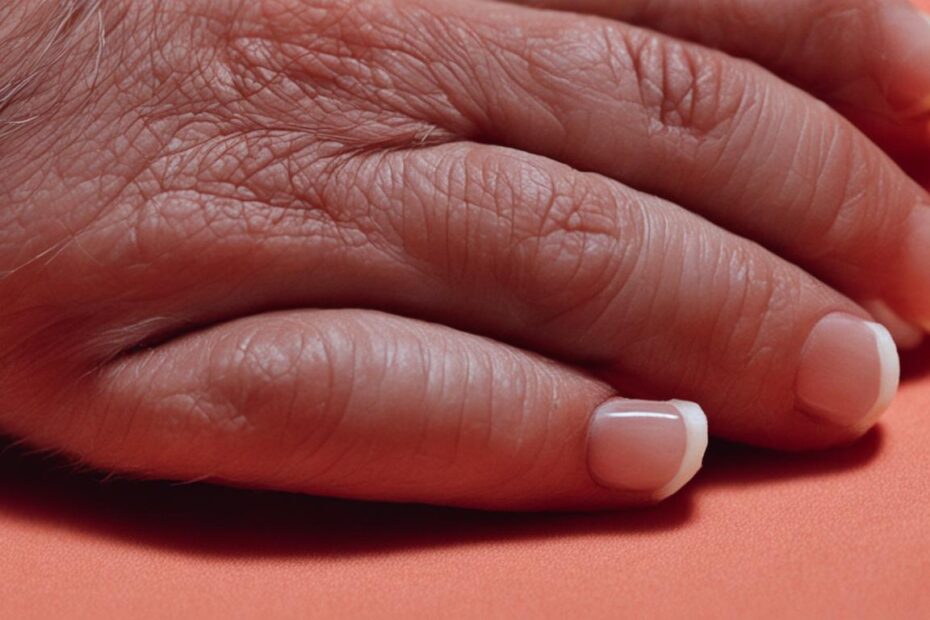Keeping your rabbit’s nails in good condition is essential for their comfort and mobility. In the wild, rabbits’ nails naturally wear down from activities like digging burrows and running on rough terrain. However, as pets, rabbits don’t have the same opportunities to naturally wear down their nails. Therefore, it’s important for rabbit owners to regularly check and trim their nails to prevent overgrowth and potential injuries.
Key Takeaways:
- Regularly check and trim your rabbit’s nails to prevent overgrowth and potential injuries.
- Long rabbit nails can cause discomfort and potential harm to both the rabbit and their handlers.
- Trimming your rabbit’s nails in a calm and controlled environment is important.
- Consider seeking professional help if you find nail trimming challenging or are afraid of hurting your rabbit.
- Most rabbits will need their nails trimmed every 1 to 2 months, but the frequency may vary depending on activity level.
Why Should You Trim Your Rabbit’s Nails?
Long rabbit nails can cause discomfort and potential harm. If left untrimmed, rabbit nails can become sharp and cause scratches or accidental injuries to both the rabbit and their handlers. Overgrown nails can also get caught on surfaces, leading to broken nails or even torn nail beds. Trimming your rabbit’s nails regularly is important for their overall nail health and to prevent any potential nail-related issues or injuries.
Rabbits in the wild naturally wear down their nails through activities like digging burrows and running on rough terrain. However, as domesticated pets, rabbits don’t have the same opportunities to naturally wear down their nails. This is why regular nail trims are necessary to maintain their nail health and prevent long rabbit nails from causing discomfort and potential damage.
Trimming your rabbit’s nails also helps prevent their nails from becoming sharp and causing scratches or injuries. Rabbits are naturally curious and can be quite active, which may lead to accidental scratching. By keeping their nails at a proper length, you can minimize the risk of accidental injuries to both your rabbit and yourself.
Additionally, overgrown nails can become entangled in surfaces such as carpet or fabric, leading to broken nails or even torn nail beds. This can be painful for rabbits and may require veterinary intervention. Regular nail trims help prevent such incidents and ensure the overall well-being of your furry friend.
Trimming your rabbit’s nails also allows you to closely monitor their nail health. By regularly inspecting their nails, you can identify any issues such as infections, overgrowth, or abnormalities. Early detection and prompt treatment can prevent further complications and ensure your rabbit’s nail health is maintained.
Ultimately, trimming your rabbit’s nails is an essential part of their overall grooming routine. By keeping their nails at a proper length, you can ensure their comfort, prevent potential harm, and promote their overall well-being.

Keeping rabbits’ nails trimmed is crucial for their comfort and to prevent potential injuries.
How to Trim Your Rabbit’s Nails
Trimming your rabbit’s nails is an important part of their regular grooming routine. Follow these steps to ensure a safe and effective nail trimming session for your furry friend.
Gather the Necessary Tools
Before you begin, gather the following tools:
- Rabbit nail clippers specifically designed for small animals
- A small towel or blanket to secure and calm your rabbit
- Styptic powder or cornstarch to stop any bleeding if the quick is accidentally clipped
Note: Do not use human nail clippers or scissors, as they can cause harm to your rabbit’s nails.
Create a Calm and Controlled Environment
Find a quiet and comfortable area where you can safely trim your rabbit’s nails. Place your rabbit on a non-slip surface, such as a table covered with a towel, to prevent them from sliding or getting scared.
Locate the Quick
The quick is the vein that runs up each nail. It’s important to locate the quick to avoid clipping it, as this can cause bleeding and pain. Rabbits with lighter colored nails have more visible quicks, while rabbits with darker colored nails may require extra care and attention.
If you find it challenging to locate the quick, gently squeeze on the clippers prior to making a cut. This will help you determine if you are nearing the quick or if it’s safe to make a clip closer to the tip of the nail.
Trim the Nails
Hold your rabbit’s paw gently but firmly, ensuring they feel secure and supported. Clip the nail at a 45-degree angle, taking off a small portion at a time. Be cautious and stop if your rabbit shows any signs of discomfort or distress.
Note: It’s better to cut less initially and make additional trims if necessary. This helps prevent accidentally cutting into the quick.
Use Styptic Powder if Bleeding Occurs
If you accidentally clip the quick and bleeding occurs, apply styptic powder or cornstarch to the affected area. This helps stop the bleeding. If the bleeding persists or if you are uncertain, consult a veterinarian for further guidance.
Reward Your Rabbit
After each successful nail trimming session, reward your rabbit with their favorite treat and plenty of praise. This positive reinforcement helps associate the experience with something enjoyable and reduces stress for future nail trims.
| Tip | Benefit |
|---|---|
| Trim your rabbit’s nails regularly | Prevents overgrowth and discomfort |
| Stay calm and patient | Reduces stress for both you and your rabbit |
| Keep styptic powder or cornstarch on hand | Helps stop bleeding if the quick is accidentally clipped |
| Reward your rabbit after each successful nail trimming session | Builds positive associations and reduces anxiety for future trims |

Here’s a step-by-step guide on how to trim your rabbit’s nails with a partner:
- Prepare a quiet and comfortable space for the nail trimming session.
- Have one person gently pick up the rabbit and hold them securely but without causing them any discomfort.
- The person trimming the nails should position themselves opposite the person holding the rabbit, ensuring a clear view and access to the nails.
- Start with the front paws and carefully examine each nail, looking for any signs of overgrowth or sharpness.
- Use rabbit-specific nail clippers to trim the nails, ensuring to cut just a small amount at a time to avoid cutting the quick.
- Communicate and work together to ensure the comfort and safety of the rabbit throughout the process.
- Take breaks if needed and offer treats or rewards to keep your rabbit calm and cooperative.
Remember, patience and gentle handling are key when trimming your rabbit’s nails with a partner. By working together and following these tips, you can help keep your rabbit’s nails short and maintain their overall nail hygiene.
Tips for Trimming Your Rabbit’s Nails by Yourself
Trimming a rabbit’s nails alone can be challenging, but with patience and practice, it can be done successfully. Here are some tips to help you trim your rabbit’s nails on your own:
- Prepare the environment: Place your rabbit on a table covered with a towel for traction. This will prevent them from slipping and help you have a stable surface to work on.
- Gently hold their paw: With a firm but gentle grip, hold one of your rabbit’s paws. This will allow you to have control while trimming their nails.
- Use appropriate nail clippers: Invest in nail clippers specifically designed for small animals like rabbits. These clippers will provide a clean and precise cut, minimizing the risk of injury.
- Start with front feet: Begin by trimming the nails on your rabbit’s front feet. Take it slow and make small cuts to avoid accidentally cutting into the quick, which is the vein that runs up each nail.
- Move to the back feet: Once you’ve finished trimming the front feet, carefully move on to the back feet. Remember to use a calm and controlled approach.
- Take breaks if needed: If your rabbit becomes fidgety or stressed, take breaks between trimming each paw. This will help keep the experience positive and reduce any anxiety or discomfort.
- Reward your rabbit: After each successful trimming session, reward your rabbit with treats or praise. This positive reinforcement will help them associate nail trimming with positive experiences.
It’s important to note that it may take time for your rabbit to get used to the nail trimming process. Be consistent, patient, and provide gentle reassurance throughout the process. With time, both you and your rabbit will become more comfortable with nail trimming.
Keep in mind that if you find the process challenging or are afraid of hurting your rabbit, it’s always a good idea to seek professional help from a veterinarian experienced in rabbit nail care. They can provide guidance, demonstrate the proper technique, and address any concerns you may have.
How Often Should You Trim Your Rabbit’s Nails?
Regular nail trimming is a crucial aspect of maintaining the health and well-being of your beloved bunny. The frequency of rabbit nail trimming largely depends on various factors, including their activity level and the natural wear their nails experience. When it comes to rabbit nail care, staying proactive and observing your furry friend’s nails is key to determining the ideal trimming frequency.
Most rabbits will require their nails to be clipped every 1 to 2 months to prevent overgrowth and potential complications. However, it’s important to regularly check the length of your rabbit’s nails for a more accurate assessment. Conducting routine inspections will allow you to identify any signs of overgrowth or sharpness that may require immediate attention.
Aside from regular trims, there are additional measures you can take to naturally maintain your rabbit’s nail length. Providing your bunny with a variety of walking surfaces that include hardwood floors and digging materials can help wear down their nails and reduce the need for frequent trimming. Encouraging physical activity and playtime will also contribute to the natural maintenance of your rabbit’s nail health.
Remember, the overall goal is to ensure your rabbit’s comfort and mobility by keeping their nails at an appropriate length. Implementing a regular nail trimming schedule and taking into consideration their individual needs will help promote optimal nail health for your furry companion.
| Factors to Consider | Ideal Trimming Frequency |
|---|---|
| High activity level | Every 4-6 weeks |
| Medium activity level | Every 6-8 weeks |
| Low activity level | Every 8-10 weeks |
Conclusion
Maintaining healthy nails for your rabbit is crucial for their overall comfort and mobility. Regular nail trimming sessions, whether done alone or with a partner, are essential to prevent overgrowth, sharpness, and potential injuries.
By following proper nail trimming techniques and providing your rabbit with appropriate surfaces to naturally wear down their nails, you can ensure their nail health and promote their overall well-being. Remember to be patient and use positive reinforcement during the nail trimming process to keep your rabbit calm and comfortable.
If you find trimming your rabbit’s nails challenging or are unsure about the process, it’s always a good idea to seek professional help from a veterinarian experienced in rabbit nail care. They can provide expert guidance and ensure your rabbit’s nails are trimmed safely and correctly.
By following these tips and prioritizing regular nail maintenance, you can help maintain healthy rabbit nails, ensuring your furry friend stays happy, healthy, and active.
FAQ
Why is it important to keep your rabbit’s nails trimmed?
Keeping your rabbit’s nails trimmed is important for their comfort and mobility. In the wild, rabbits naturally wear down their nails through activities like digging and running on rough terrain. However, as pets, rabbits need help in maintaining their nail health. Trimming their nails regularly prevents overgrowth, discomfort, and potential injuries.
How can long rabbit nails be harmful?
Long rabbit nails can cause discomfort and potential harm. If left untrimmed, they can become sharp and cause scratches or accidental injuries to both the rabbit and their handlers. Overgrown nails can also get caught on surfaces, leading to broken nails or torn nail beds.
How do you trim your rabbit’s nails?
To trim your rabbit’s nails, it’s important to locate the quick, which is the vein that runs up each nail, to avoid clipping it. Use nail clippers specifically designed for small animals like rabbits. If you find the process challenging or are afraid of hurting your rabbit, consider seeking professional help from a veterinarian experienced in rabbit nail care.
What are some tips for trimming your rabbit’s nails with a partner?
If possible, it’s easier to trim your rabbit’s nails with the help of a partner. One person can hold the rabbit still and calm, while the other person uses the clippers to trim the nails. Position the rabbit’s paws outward or create a half cradle with one person holding the rabbit and the other trimming the nails. Take breaks and reposition the rabbit as needed to ensure a comfortable and effective nail trimming session.
How can you trim your rabbit’s nails by yourself?
Trimming a rabbit’s nails alone can be challenging, but with patience and practice, it can be done successfully. Place your rabbit on a table covered with a towel for traction and gently hold one of their paws. Use nail clippers to trim the nails, starting with the front feet and then moving to the back feet. Take breaks if your rabbit gets fidgety and reward them with treats after each successful trimming session.
How often should you trim your rabbit’s nails?
Most rabbits will need their nails trimmed every 1 to 2 months. However, the frequency may vary depending on the rabbit’s activity level and the natural wear their nails experience. Regularly check the length of your rabbit’s nails to ensure they are not getting too long. Providing a variety of surfaces for your rabbit to walk on, including hardwood floors and digging materials, can help naturally wear down their nails and reduce the need for frequent trims.
What is the importance of maintaining healthy rabbit nails?
Maintaining healthy rabbit nails is essential for their overall comfort and mobility. Regular nail trims prevent overgrowth, sharpness, and potential injuries. By following proper nail trimming techniques and providing appropriate surfaces for your rabbit to wear down their nails, you can ensure their nail health and promote their overall well-being.


